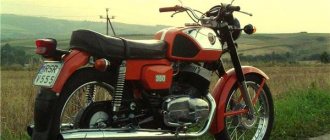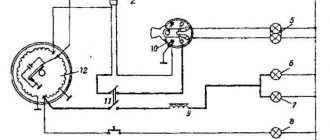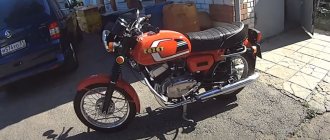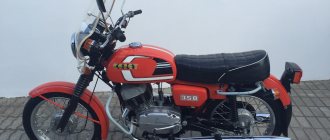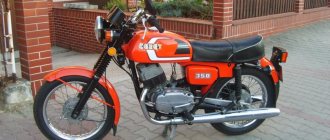By the beginning of the 30s of the last century, when the first Jawa motorcycles had already appeared in Czechoslovakia, the Ceska Zbrojovka (CZ) arms factory also decided to switch to the production of motorcycles. The first pancake turned out to be lumpy - motorbikes with a 60 cc engine mounted on the front wheel were considered a very unsuccessful technological solution. In 1932, the CZ plant began mass production of motorbikes with a two-stroke 76 cc engine, which was installed at the bottom of the frame. A year later, a new model with a 100 cc engine appeared, and then a 175 cc motorcycle with a double stamped frame and a three-speed gearbox. Modernization continued, and in 1936 the plant produced 250 cc Cezet motorcycles, which later included models with a 350 cc single-cylinder engine and a 500 cc two-cylinder engine. The prototype of the post-war Chezet motorcycles, which made the CZ plant famous, was a lightweight 125 cc motorcycle with a tubular frame released at the very end of the 30s.
Resuming the production of light motorcycles after the end of the war, the plant produced an improved Cezet motorcycle with a front telescopic fork, and equipped the subsequent model with a spark plug rear suspension. However, the dominance of Jawa motorcycles in the motorcycle market of that time was making itself felt, so in 1954, CZ developers decided to start producing new motorcycles designed at the Jawa plant, which were equipped with 123 and 148 cc two-stroke engines. This decision was understandable and justified, since after the war CZ entered the Jawa association. Despite the fact that the histories of Jawa and CZ closely overlap, the CZ plant paved its own path in the Czech motorcycle industry.
In the 50s, Cezet racing motorcycles with a single-cylinder four-stroke engine and Cezeta scooters, developed by the leading designer of the plant Yaroslav Koch, appeared. In 1960, the motorcycle industry was reorganized, and at the government level it was decided to transfer the production of Czech motorcycles to another plant. Jawa and CZ had no choice but to jointly, at both enterprises, release a unified family of motorcycles with an engine capacity of 125 to 350 cc. The CZ plant launched mass production of 125 and 250 cc unified motorcycles with single-cylinder two-stroke engines, but this family was soon replaced by new Cheset motorcycles with an engine capacity of 172 cc.
The famous Cezet cross-country motorcycle rolled off the assembly line in 1962 - it was a model with a single-cylinder two-stroke engine with a capacity of 250 cc. Riders on the Cezet 250 motorcycle repeatedly took pride of place in the World Championships, and this was truly a stellar period for Cezet motorcycles, which lasted until the end of the 60s. Then another significant event took place both for CZ and for Soviet motorsport. In 1963, the attention of the Czechs was attracted by the famous racer Igor Grigoriev, who was invited to compete on a Cezet motorcycle. The result exceeded all expectations, and Grigoriev became a signature CZ racer, managing to climb to the highest steps of the podium. Igor Grigoriev was even accepted as an honorary employee of the CZ plant, because it was difficult to think of a better advertisement for Chezet motorcycles than victories in the Championships. From 1964-1969, the championship titles on the legendary Cezet-250 motorcycle were won three times by the Belgian Joel Robber, who in 1965 lost to our Victor Arbekov, and in the 500 cc class by the German racer Paul Friedrichs on the Cezet-360 motorcycle.
During the same period of time, the Cheset and Java motorcycles began to enter the domestic market, where hitherto unprecedented success awaited them. In parallel, the CZ plant continued to develop not only light motorcycles, but also enduro-style motorcycles. By the 70s, the sporting achievements of Cezet motorcycles were a thing of the past, so the plant stepped up the production of road motorcycles, producing 250 cc and 350 cc models. The collapse of the socialist bloc and the appearance of updated motorcycles on the Western market had a significant impact on Czech manufacturers. The Jawa parent plant found itself in a worse position than CZ, which managed not only to refocus on the production of other products, but also to establish ties with the Italian concern Cagiva, which showed increased interest in the Eastern European market and in Czech-made motorcycles.
The Italians bought the CZ plant and in the early 90s launched the production of the Roadster road motorcycle with two engine options: a 124 cc two-stroke Cagiva engine and a four-stroke 200 cc CZ engine. In Europe, all motorcycles produced at the CZ plant were sold under the Cagiva brand. However, this Eastern European project did not live up to expectations and brought significant losses, so in the late 90s, the Cagiva concern abandoned the further production of motorcycles at the production facilities of the CZ plant, which at one time played such a prominent role in the history of not only the Czech, but also of the entire world motorcycle industry.
MY MOTORCYCLE
For a good ten years, Czech motocross motorcycles were among the best in the world - as evidenced by the impressive collection of awards collected by riders from Czechoslovakia, the USSR, the GDR, Belgium and many other countries. And for us, “cheeses” became the equipment on which athletes of the Soviet school of motocross honed their skills.
After the Second World War, motorsport was dominated by the players of the “first league”: Great Britain, Italy, and a little later (for obvious reasons - in the 40s the Germans were simply excommunicated from international competitions) - Germany. But the “economic miracle” led to the fact that the population of these countries began to switch to cars in the late 50s - and local motorcycle companies began to save on sports. Which gave the players of the “second league” a chance.
The two largest motorcycle companies in Czechoslovakia - Jawa and ČZ - although they came under state control after the war, did not lose their petty-bourgeois habits. Such, for example, as advertising products through sports victories. The Czechs achieved particular success in the FIM Six Days: from 1952 to 1959, the Czechoslovakian team won the main prize, the International Trophy, five times.
The first cross-country 250 cc ČZ – model 250 / 964.
Since 1957, Europe began to hold a motocross championship in the 250 cm³ class, and the Czechs again did not lose face. Jaromir Cizek took third place on a Jawa motorcycle in his debut season, and the following year became European champion.
The workers of the ČZ plant were heartily envious of the success of their rival friends and also decided to make a 250 cc motocross motorcycle. Since the company was then producing serial motorcycles with smaller cubic capacity (125 and 175 cm³), at first its designers used a four-stroke overhead shaft engine from a racing machine. It turned out that it was completely unsuitable for off-road use (what the British did with the 500 cc AJS did not work with a high-speed engine with half the cubic capacity).
And then, in full accordance with the proverb about saving drowning people, the young racer Zdenek Polanka took up the matter in 1959. Taking the successful multi-day vehicle ČZ 175/961 as a basis, he, with the help of mechanic Vaclav Šiška, increased the engine displacement to 200 cm³, boosting it to 20 hp. He installed the power unit in the chassis of a multi-day vehicle: a light frame split at the bottom, made of round pipes made of chrome-molybdenum steel.
The ČZ 175 / 961, which competed successfully in the Six Days, became the basis for the creation of the brand’s first cross-country motorcycle.
The “Samodelka” successfully competed in local competitions, and the factory designers decided to use it as the basis for their 250 cc “cross bike” - model 250/964. They raised the working volume to 246.3 cm³, choosing a dimension of 70.0 × 64.0 mm. The cast iron cylinder had two purge and two outlet windows. The crankshaft sat on two ball bearings on the engine transmission side and a double-row bearing on the ignition side. The connecting rod had a bronze bushing in the upper head and a bulk roller bearing in the lower head. The new engine produced 23 hp. at 6250 rpm. The transmission - a gear main gear with an intermediate gear, a four-speed gearbox and a clutch mounted on the gearbox drive shaft - and the chassis were transferred from the multi-day vehicle without significant changes. And although practice has shown that the chassis and especially the gearbox are weak for this engine, factory driver Vlastimil Valek twice in the 1960 season - in Poland and Great Britain - rose to third place at the stages of the European Championship.
By the 1962 season, the plant's designers under the leadership of Pavel Gusak had significantly redesigned the car. The transmission has completely changed: there is a new clutch and gearbox and a motor transmission with two gears. The frame was rebuilt, and the gas tank, saddle frame and fenders were made of fiberglass, which reduced the weight of the motorcycle to 106 kg. That year, the championship in the 250 cm³ class received the status of a world championship - and Czech riders on the updated ČZ performed well. Vlastimil Valek won his “native” stage in Czechoslovakia and took fourth place at the end of the championship, and his teammate Karel Pilar took fifth.
Riders on ČZ motorcycles won seven gold medals, 11 silver and 10 bronze at the motocross world championships.
Feeling the taste of victory, the Czechs set about modernizing the motorcycle with renewed energy. In the 250/967 model, the crankshaft was completely redesigned and the clutch was moved to it. A forged piston and a modified cylinder head made it possible to increase power to 27 hp. The new front fork had a significant travel for those times - 170 mm. The wheel hubs and crankcase parts were made of magnesium alloy, which, together with other measures to lighten the car, made it possible to achieve a record low weight of 95.5 kg. On this motorcycle Vlastimil Valek won four stages of the world championship in 1963, finishing second. The riders of the Soviet team also received the same ČZ; Igor Grigoriev won a bronze medal, opening the account of the successes of our cross-country athletes.
At the World Championship stage in the 500 cm³ class in Czechoslovakia, ČZ entered two motorcycles with engines with a displacement increased to 263 cm³. Valek won the first race - this was the first victory of a two-stroke machine in the “five hundred”. True, Rolf Tibblin took the second race on a Husqvarna with such an advantage that he secured the overall victory at the stage.
For the 1964 season, the designers again completely redesigned the gearbox, finally achieving commendable reliability. But even more successful was the decision to produce a series of crossover devices, putting them up for sale for the first time. One of these motorcycles was bought by the young Belgian racer Joel Robert, who had already appreciated the ČZ brand - he competed on a Czech machine in the Six Days. Robert amazed everyone with his new driving style: he did not let off the gas in turns, driving through them in a controlled skid with wheel slipping, and covered most of the route while standing on the pegs. He eventually won four rounds and became the 1964 world champion, the first title for the Czech brand. Our driver Viktor Arbekov took third place, and Igor Grigoriev took fourth place. But Valek, who switched to Jawa, became only the seventh.
“I knew I had the best car in the world. Neither Husqvarna motorcycles nor Greeves motorcycles can compete with it.” Viktor Arbekov, 1965 world champion.
In the “five hundred”, manufacturers of four-stroke cars pushed through a new regulation - the working volume of motorcycles competing in this class had to exceed 350 cm³. In response, the Czechs created a 360 cc (80.0 × 72.0 mm) motocross motorcycle. Structurally, it was similar to the 250 cc, but with one important difference: an aluminum alloy cylinder with a pressed cast iron liner. The new engine developed 32 hp. at 6500 rpm.
The 1965 season was no less successful for the Czech brand. Viktor Arbekov became world champion in the 250 cm³ class, Joel Robert became vice-champion. The new 360 cc machine also performed well: driver from the GDR Paul Friedrichs won three stages and became second in the championship, Swede Rolf Tibblin, who moved to ČZ, was third. And Igor Grigoriev won the home stage - in the USSR.
Already in 1964, based on the 250 cc unit, a 360 cc unit was created.
The success of Czech motorcycles aroused great demand; the geography of supplies even included Australia and the USA. True, serial motorcycles, due to an increase in production volumes, have become simpler: the crankcase is made of aluminum rather than magnesium alloy, and steel gas tanks. But for the 1966 season, factory cars received new cylinders, with one exhaust window and three-channel purge. The aluminum lined cylinder was now used on the 250 cc version. Instead of a bulk roller bearing, a needle bearing was installed in the lower head of the connecting rod. The power of the 250 cc engine increased to 29 hp, the 360 cc engine - to 36 hp. On the 360 cc unit, the designers moved the clutch to the input shaft of the gearbox. The exhaust pipes moved upward, which made it possible to drive the car more confidently in deep ruts. The '66 World Championship in the 250 cc class was won by Swede Torsten Hallman on a Husqvarna. But the next three places were taken by ČZ riders: Joël Robert - Petr Dobry - Viktor Arbekov. But in the “five hundred” racers on ČZ - Paul Friedrichs and Rolf Tibblin - made a winning double. Fifth place was taken by Englishman Dave Bickers, who rode a Czech motorcycle, and seventh by Igor Grigoriev.
Bearing in mind that the title is more difficult to hold than to win, Czech designers devoted all their efforts to modernizing the “500” for the 1967 season. The engine displacement first increased to 383 cm³, later to 402 cm³. A new duplex frame was developed for the car. The work was not in vain: Paul Friedrichs again won the championship title, Dave Bickers won the bronze medal. The racer from the USSR Gunar Draugs took sixth place. In the 250 cm³ class, Joel Robert became second, Viktor Arbekov fourth. Speaking at ČZ, the future champion Gennady Moiseev, who took third place at the World Championship stage held in the USSR, showed for the first time.
Enduro ČZ 250 / 988.
In the 1968 season, serial ČZ motocross motorcycles became closer in their technical design to the factory devices of the 1966 model: three-channel purge, one exhaust window. But factory cars went further, receiving contactless electronic ignition from the Spanish company Femsa, with two spark plugs per cylinder. Friedrichs again won the championship title in the 500, Robert managed to regain the crown in the 250 cm³ class. Soviet riders won the Trophy of Nations - the world team championship in the 500. But the sensation of the year was the sixth place of Swede Olle Pettersson in the 250 cm³ class on a Suzuki motorcycle: for the first time, Japanese concerns became interested in motocross. Few foresaw that they would soon change the whole picture...
Joel Robert retained the title in 1969. Second place in the 250 cm³ class was taken by another Belgian on ČZ - Sylvain Geboers. Czech riders Stodulka and Konecny took fourth and fifth places, ninth-tenth were shared by Moiseev and Kavinov, who scored equal points. In total, riders on Czech motorcycles took seven places in the top ten. But in the “500” everything was sadder: Friedrichs fell back to third place, losing to Bengt Aberg on Husqvarna and John Banks on BSA.
By the 1970 season, the Japanese presented another sensation: Suzuki immediately bought both Robert and Geboers en masse! This couple brought the concern its first double. It is interesting that third place at the end of the championship was taken by another Belgian, but who remained loyal to the ČZ brand - Roger de Coster. But in the “500” the best ČZ driver, Friedrichs, became only fourth.
Cross-section of the power unit of the ČZ motocross model 1971. The clutch is on the gearbox shaft.
Meanwhile, the scale of production of ČZ cross-country motorcycles grew rapidly: in 1969 the company produced 2,000 such machines, in 1970 - 5,000, in 1971 - 8,000. True, this growth was mainly caused by the fact that this equipment began to be purchased in large quantities USSR for DOSAAF organizations. And massive Soviet purchases played the same cruel joke on the ČZ cross-country cars as they did on the Jawa road cars: having received a stable sales market, production workers lost the incentive to introduce design innovations. From that time on, the gap between production motorcycles and those specially prepared for the factory team began to grow. The serial ones now changed more aesthetically: in 1971 they received characteristic “yellow gas tanks” with a large factory emblem, and in 1973 - faceted tanks, nicknamed “coffins” for their characteristic shape.
The characteristic shape of the “yellow gas tank” became a sign of Czech cross-country racers in 1971. The same tanks were then installed on ČZ road motorcycles.
However, little by little, components and parts tested in racing appeared on production motorcycles. Thus, in 1973, cylinder heads with fan-shaped fins, first used on the Friedrichs apparatus in 1970, were introduced into the series. A five-speed gearbox debuted on the factory 250cc bike in 1973, and on the production bike in 1976 (to revert to a four-speed in 1983). In 1974, the factory team received air shock absorbers for the rear suspension, introduced into the series already in 1976.
The Czechs decided to install the proven and quite reliable motor, which was also produced in a decent series, in “civilian” cars. True, the ČZ 250/986 road motorcycle is derated to 25 hp. engine, shown in 1972, never went into production. But the enduro ČZ 250/988 with a 24-horsepower engine version was produced in small series, mainly for export to the West, from 1973 to 1977.
The faceted fuel tank and fan-finned cylinder head are signature features of the 1974 motorcycles.
In the 70s, factory designers paid more attention to the new cross-country bikes with a capacity of 125 cm³. And in the 250 cm³ class, their last serious fight was in 1974, when Jaroslav Falta almost became the world champion. Alas, a double false start at the last stage dashed his hopes - after considering all the documents, the FIM gave the title to Gennady Moiseev, who rode KTM (more details in “Moto” No. 12-2014). Of course, both Czechs and fans of Czech motorcycles consider Falta to be the true champion. And in 1975, the plant produced a batch of Falta Replica cross-country shoes, somewhat close in their characteristics to the factory car.
The victory of Czechoslovakia in the team world championship - “Motocross of Nations” - in 1975 was a sensation. The Czechs managed to push the Belgian team into second place, for which three (!) current world champions played. The victory was given particular significance by the fact that the team exhibited an almost production car, since the plant did not make special vehicles in the “five hundred” that year.
Soviet riders Viktor Arbekov, Igor Grigoriev, Gunar Draugs, Vladimir Kavinov, Gennady Moiseev, Pavel Rulev and many others successfully competed on ČZ motorcycles in international competitions.
And on motorcycles for the factory team, more and more imported components appeared - Mikuni carburetors, Marzocchi front forks, Girling or Ohlins rear shock absorbers. Since 1976, Czech designers have tested a reed valve on the inlet. Alas, production units did not receive these delicacies - and as a result, serious racers in the West no longer bought ČZ. They became the lot of beginners and those who purchased a car for rides on the ranch.
A 1983 factory team motorcycle with monoshock rear suspension.
The last successful season for the brand was 1980. At that time, not only Czech riders Jaroslav Falta and Jüri Huravy competed for ČZ, but also Gennady Moiseev and Vladimir Kavinov, who had parted ways with Austrian motorcycles. Falta won two races at the beginning of the season and finished seventh in the championship. Kavinov brought the ČZ brand its last victory at the World Championship stage, winning the USSR Grand Prix.
In 1982, the factory team's motorcycles received a rear suspension with progressive characteristics. A year later, liquid-cooled prototypes appeared on the tracks. But Czech motorcycles were already catastrophically behind foreign cars in their development, and even branded riders could not break into the top ten. And in 1985, the factory team was liquidated.
An experimental motorcycle from 1985 with a liquid-cooled engine.
And the plant continued to produce cross-country motorcycles of a frankly archaic design for the 80s: air-cooled, rear suspension with two shock absorbers and drum brakes. In 1988, a prototype of the future serial device ČZ 250/520, a much more modern concept, was shown, but it never went into production. And with the collapse of the last major customer - the USSR - the production of cross-country shoes was curtailed in 1992.
The ČZ concern still exists today, producing auto parts, chains, turbochargers and industrial equipment. But he has long had nothing to do with the production of motorcycles. True, from time to time there are rumors about the revival of cross-country dogs. The last time the brand was featured on this issue was literally a few months ago - but that was only a batch of Italian TM motorcycles with a Czech emblem on the gas tank.
Issue: MOTO Magazine - July 2015
Author: Alexander VORONTSOV, photo from the editorial archive
